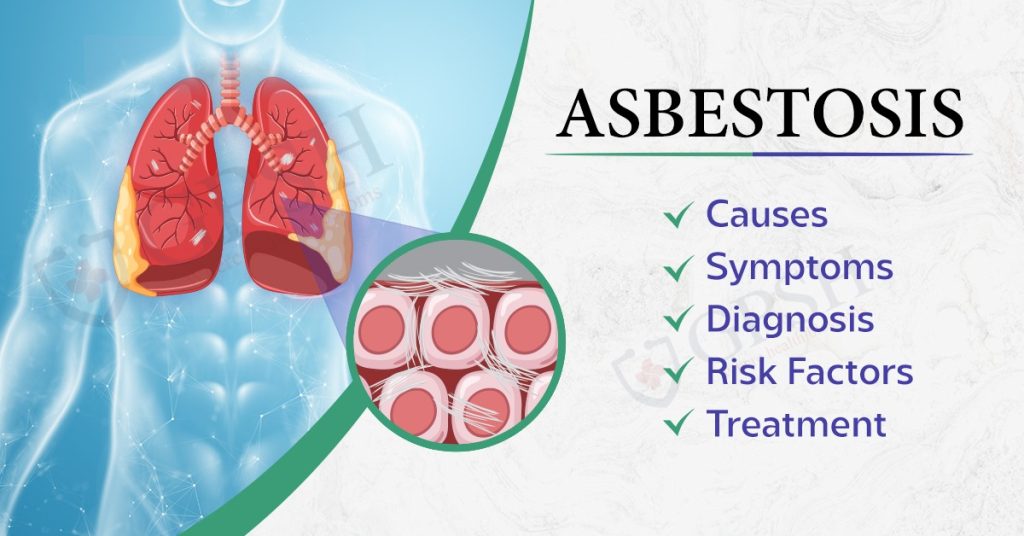What is Asbestosis?
Asbestosis is a chronic lung condition caused by prolonged exposure to asbestos fibers, which can lead to scarring of the lung tissue. This debilitating disease typically develops over many years, often decades, after initial exposure to asbestos-containing materials commonly found in construction, shipbuilding, and manufacturing industries. Asbestos fibers, when inhaled, can lodge themselves deep within the lungs, triggering inflammation and scarring that impair respiratory function. In this comprehensive exploration of asbestosis, we will delve into its etiology, pathophysiology, clinical manifestations, diagnostic approaches, treatment options, and preventive measures. Additionally, we will examine the legal and social implications surrounding asbestos exposure, including regulatory efforts to mitigate its risks and provide compensation for affected individuals. Through a multidimensional analysis, we aim to elucidate the complexities of this occupational disease and its profound impact on public health and safety.
Causes of Asbestosis
The primary causes and risk factors associated with asbestosis include:
- Occupational Exposure: People who work in industries where asbestos is used or mined are at the highest risk of developing asbestosis. These industries include construction, shipbuilding, mining, manufacturing, and asbestos removal.
- Environmental Exposure: Individuals who live near asbestos mines or asbestos-containing industries may be exposed to asbestos fibers in the environment, increasing their risk of developing asbestosis.
- Duration of Exposure: The risk of developing asbestosis is directly related to the duration and intensity of exposure to asbestos fibers. Long-term or repeated exposure over many years significantly increases the risk of developing the condition.
- Type of Asbestos: Different types of asbestos fibers exist, including chrysotile, amosite, and crocidolite. While all types can cause health problems, amphibole fibers like amosite and crocidolite are considered more hazardous and have been associated with a higher risk of developing asbestosis compared to chrysotile fibers.
- Smoking: Smoking tobacco increases the risk of developing asbestosis in individuals exposed to asbestos fibers. Smoking weakens the lungs and impairs their ability to clear asbestos fibers, exacerbating the damage caused by asbestos exposure.
- Other Factors: Factors such as age, genetic predisposition, and pre-existing lung conditions may also influence an individual’s susceptibility to developing asbestosis.
You can read also:- Achondroplasia: Causes, Symptoms, Diagnosis, and Treatment
Symptoms of Asbestosis
Asbestosis is a chronic lung condition caused by prolonged exposure to asbestos fibers. The symptoms of asbestosis typically develop gradually over time and may not become apparent until several decades after the initial exposure. Common symptoms of asbestosis include:
- Shortness of Breath: This is often the earliest and most common symptom of asbestosis. It may start as exertional dyspnea (difficulty breathing during physical activity) and progress to difficulty breathing even at rest as the condition worsens.
- Persistent Cough: A chronic cough that does not go away, often accompanied by sputum production, is another common symptom of asbestosis.
- Chest Tightness or Pain: Some individuals with asbestosis may experience chest tightness or discomfort, which can range from mild to severe.
- Clubbing of Fingers and Toes: In advanced cases of asbestosis, the fingertips and toes may become enlarged and rounded, a condition known as clubbing.
- Fatigue: Feeling excessively tired or fatigued, even with minimal physical exertion, is a common symptom of asbestosis.
- Loss of Appetite and Weight Loss: Asbestosis can cause a decreased appetite and unintentional weight loss due to the strain on the lungs and the body’s increased energy expenditure in trying to breathe.
- Crackling Sounds in the Lungs (Velcro Rales): When listening to the lungs with a stethoscope, healthcare providers may hear crackling or Velcro-like sounds, which indicate the presence of fibrosis and scarring in the lungs.
Diagnosis of Asbestosis
Diagnosing asbestosis typically involves a combination of medical history review, physical examination, imaging studies, pulmonary function tests, and sometimes a biopsy. Here’s an overview of the diagnostic process:
- Medical History and Physical Examination: The doctor will inquire about the patient’s occupational history, including any known exposure to asbestos. They will also ask about symptoms such as shortness of breath, cough, and chest pain. A physical exam may reveal signs such as clubbing of the fingers and toes, and crackling sounds in the lungs (Velcro rales).
- Imaging Studies:
○ Chest X-ray: This is often the first imaging test performed. It may show characteristic findings such as linear streaks or small, irregular opacities in the lower lobes of the lungs.
○ High-Resolution Computed Tomography (HRCT) Scan: HRCT provides more detailed images of the lungs and can detect early signs of fibrosis and scarring associated with asbestosis. - Pulmonary Function Tests (PFTs): These tests measure lung function and can help assess the severity of respiratory impairment. Common PFTs include spirometry, which measures lung volume and airflow, and diffusion capacity testing, which evaluates how well oxygen moves from the lungs into the bloodstream.
- Biopsy (in some cases): A biopsy may be necessary to confirm the presence of asbestos fibers and to distinguish asbestosis from other lung conditions with similar symptoms and radiographic findings. Biopsy samples may be obtained through bronchoscopy (using a thin, flexible tube to collect tissue samples from the lungs) or surgical biopsy.
Risk Factors of Asbestosis
Asbestosis is primarily caused by prolonged exposure to asbestos fibers, but several risk factors can increase the likelihood of developing the condition. These risk factors include:
- Occupational Exposure: Individuals who work in industries where asbestos is used or mined are at the highest risk of developing asbestosis. These industries include construction, shipbuilding, mining, manufacturing, and asbestos removal. Jobs that involve direct handling or disturbance of asbestos-containing materials pose the greatest risk.
- Duration of Exposure: The risk of developing asbestosis is directly related to the duration and intensity of exposure to asbestos fibers. Long-term or repeated exposure over many years significantly increases the risk of developing the condition.
- Type of Asbestos: Different types of asbestos fibers exist, including chrysotile, amosite, and crocidolite. While all types can cause health problems, amphibole fibers like amosite and crocidolite are considered more hazardous and have been associated with a higher risk of developing asbestosis compared to chrysotile fibers.
- Smoking: Smoking tobacco increases the risk of developing asbestosis in individuals exposed to asbestos fibers. Smoking weakens the lungs and impairs their ability to clear asbestos fibers, exacerbating the damage caused by asbestos exposure. The combination of smoking and asbestos exposure significantly increases the risk of developing lung cancer.
- Age at Exposure: The age at which an individual is exposed to asbestos can influence their risk of developing asbestosis. Generally, the risk increases with age, as cumulative exposure over time leads to a higher burden of asbestos fibers in the lungs.
- Gender: Historically, men have had higher rates of occupational asbestos exposure due to the prevalence of asbestos-related industries. Consequently, men have traditionally been at higher risk of developing asbestosis. However, as more women entered the workforce in industries with asbestos exposure, gender disparities in
- Pre-existing Lung Conditions: Individuals with pre-existing lung conditions, such as chronic obstructive pulmonary disease (COPD) or interstitial lung diseases, may be at increased risk of developing asbestosis if exposed to asbestos.
Treatments of Asbestosis
Asbestosis is a chronic lung condition for which there is currently no cure. However, treatment focuses on managing symptoms, slowing disease progression, and improving quality of life. Treatment options for asbestosis may include:
- Smoking Cessation: If the individual with asbestosis is a smoker, quitting smoking is essential. Smoking further damages the lungs and increases the risk of developing complications such as lung cancer and exacerbating respiratory symptoms.
- Oxygen Therapy: Supplemental oxygen therapy may be prescribed to relieve shortness of breath and improve oxygen levels in the blood. This can help reduce fatigue and improve overall quality of life, particularly during physical activity and sleep.
- Medications:
○ Bronchodilators: These medications help to relax and widen the airways, making it easier to breathe.
○ Corticosteroids: In some cases, corticosteroids may be prescribed to reduce inflammation in the lungs and alleviate symptoms, although their effectiveness in treating asbestosis is limited. - Pulmonary Rehabilitation: Pulmonary rehabilitation programs offer a comprehensive approach to managing respiratory symptoms and improving lung function. These programs typically include exercise training, education, nutritional counseling, and breathing techniques to enhance lung capacity and overall fitness.
- Antifibrotic Therapy: Recently, antifibrotic medications such as pirfenidone and nintedanib have shown promise in slowing the progression of fibrosis in certain types of interstitial lung diseases, including asbestosis. These medications may be considered in some cases to help reduce lung function decline.
- Lung Transplantation: In severe cases of asbestosis with advanced respiratory failure and poor quality of life, lung transplantation may be considered as a last resort. However, candidacy for lung transplantation depends on various factors, including overall health, age, and the presence of other medical conditions.
Complications of Asbestosis
Asbestosis, a chronic lung condition caused by prolonged exposure to asbestos fibers, can lead to various complications, some of which can be serious or life-threatening. These complications may include:
- Progressive Respiratory Impairment: Asbestosis causes progressive scarring and fibrosis of the lung tissue, which gradually impairs lung function. Over time, this can lead to increasing difficulty breathing, reduced exercise tolerance, and ultimately respiratory failure.
- Pulmonary Hypertension: Asbestos-related lung disease can lead to pulmonary hypertension, a condition characterized by high blood pressure in the arteries of the lungs. This can strain the heart and lead to symptoms such as shortness of breath, chest pain, and fatigue.
- Cor Pulmonale: Cor pulmonale is a type of heart failure that occurs when the right side of the heart becomes enlarged and strained due to lung disease or pulmonary hypertension. Asbestosis can contribute to the development of cor pulmonale, leading to symptoms such as fluid retention, swelling in the legs and ankles, and a bluish tint to the skin (cyanosis).
- Increased Risk of Lung Cancer: Individuals with asbestosis have an increased risk of developing lung cancer, particularly if they are also smokers. Asbestosis and asbestos exposure are significant risk factors for the development of lung cancer, and the combination of asbestos exposure and smoking further amplifies this risk.
- Mesothelioma: Asbestos exposure is the primary cause of mesothelioma, a rare and aggressive cancer that affects the lining of the lungs, abdomen, or other organs. While mesothelioma is relatively rare compared to lung cancer, individuals with a history of asbestos exposure, including those with asbestosis, have an elevated risk of developing this disease.
- Respiratory Infections: Asbestosis can weaken the immune system and impair the lungs’ ability to clear mucus and bacteria, increasing the risk of respiratory infections such as pneumonia and bronchitis.
- Reduced Quality of Life: Asbestosis can significantly impact an individual’s quality of life due to symptoms such as shortness of breath, cough, fatigue, and limited physical activity. It can also affect emotional well-being, leading to anxiety, depression, and social isolation.
- Complications from Treatment: Some treatments for asbestosis, such as oxygen therapy or medications, may have side effects or complications. For example, long-term oxygen therapy can dry out the nasal passages and increase the risk of respiratory infections, while certain medications may cause gastrointestinal issues or other adverse reactions.
- Death: In severe cases, particularly those complicated by respiratory failure, pulmonary hypertension, or other serious medical conditions, asbestosis can be life-threatening.
You Can Read also:- Ehrlichiosis: Causes, Symptoms, Risk Factors, Diagnosis and Treatment
Prevention of Asbestosis
Prevention of asbestosis primarily involves minimizing exposure to asbestos fibers in the workplace and other environments where asbestos may be present. Here are several key strategies for preventing asbestosis:
- Workplace Safety Measures: Employers should implement strict safety protocols to minimize asbestos exposure in the workplace. This includes conducting asbestos risk assessments, providing appropriate personal protective equipment (PPE) such as respirators and protective clothing, and implementing engineering controls to prevent the release of asbestos fibers into the air.
- Asbestos Abatement and Removal: When asbestos-containing materials are identified in buildings or structures, proper abatement and removal procedures should be followed by trained and certified professionals. This may involve encapsulation, enclosure, or complete removal of asbestos-containing materials to prevent exposure.
- Regulatory Compliance: Employers must adhere to regulations and guidelines established by occupational health and safety agencies, such as the Occupational Safety and Health Administration (OSHA) in the United States, to protect workers from asbestos exposure. Compliance with regulations ensures that appropriate measures are in place to minimize the risk of exposure.
- Worker Education and Training: Employers should provide comprehensive training to workers who may encounter asbestos as part of their job duties. Training should cover topics such as asbestos awareness, proper handling procedures, use of PPE, and emergency response protocols.
- Environmental Monitoring: Regular monitoring of air quality in workplaces where asbestos is present can help ensure that exposure levels remain within safe limits. Monitoring should be conducted by qualified professionals using appropriate sampling and analysis methods.
- Personal Hygiene Practices: Workers who may be exposed to asbestos should practice good personal hygiene to minimize the risk of inadvertently spreading asbestos fibers. This includes washing hands and face thoroughly before eating, drinking, or smoking, and changing out of work clothes before leaving the job site.
- Medical Surveillance: Employers should implement medical surveillance programs to monitor the health of workers who may be exposed to asbestos. Regular medical examinations, including lung function tests and chest X-rays, can help detect early signs of asbestos-related diseases such as asbestosis.









